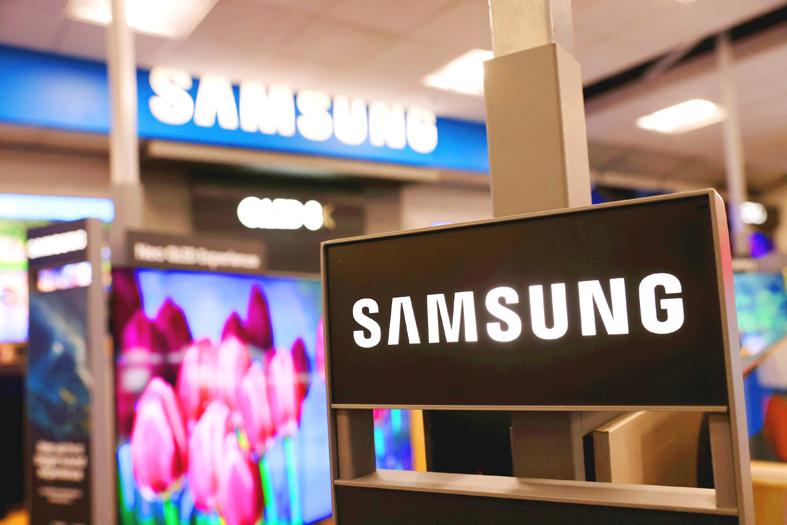Samsung Electronics Co is to build an advanced US chip plant in Texas as US President Joe Biden’s administration prioritizes supply chain security and greater semiconductor capacity on US soil.
South Korea’s largest company has picked the city of Taylor, about 50km from its manufacturing hub in Austin, a person familiar with the matter said.
The local government pulled out the stops to snag Samsung, including waiving 90 percent of property taxes for a decade and 85 percent for the following 10 years, the person said.

Photo: Reuters
Samsung and Texas officials were to announce the decision yesterday afternoon, people familiar with the matter said.
A Samsung representative said that it had not made a final decision and declined further comment.
Samsung is hoping to win more US clients and narrow the gap with Taiwan Semiconductor Manufacturing Co (TSMC, 台積電).
Its decision, which came months after de facto Samsung leader Jay Y. Lee was released from prison on parole, follows plans by TSMC and Intel Corp to spend billions on cutting-edge facilities globally.
The industry triumvirate is racing to meet a surge in demand following COVID-19 restrictions that have stretched global capacity, while anticipating that more connected devices from vehicles to homes will require chips.
The new plant would augment Samsung’s already large presence in the area, where it has invested about US$17 billion to date on a sprawling complex that houses more than 3,000 employees and fabricates some of the country’s most sophisticated chips.
Samsung is planning to invest another US$17 billion and create about 1,800 jobs over the first 10 years, documents that the company submitted to Taylor officials showed.
South Korea’s Yonhap news agency and the Wall Street Journal had reported earlier on Taylor’s selection.
The Biden administration has repeatedly voiced the need to increase chip production in the US, saying that it is the best way to compete with China and mitigate supply chain disruptions, such as the one stemming from COVID-19.
Last month, the US created an “early alert system” to detect COVID-19-related shocks.
To identify potential issues, it asked producers and consumers of semiconductors to complete a survey about inventories, demand and delivery systems.
The White House has also called on Democrats in the US House of Representatives to pass a US$52 billion bill known as the CHIPS Act, which would fund domestic semiconductor research and manufacturing.
Administration officials have pointed to the bill when pressed about security concerns in Taiwan, the world’s foremost chip producer.
US Secretary of Commerce Gina Raimondo said that the US Congress should pass the legislation as “quickly as possible” when asked if the US needed a clearer defense strategy related to Taiwan.
Samsung is going head-to-head in Intel’s backyard with TSMC, which is on track to start production on its own US$12 billion chip plant in Arizona by 2024.
Its envisioned US foundry is to adopt ASML Holding NV’s extreme ultraviolet lithography equipment and TSMC aims to mass-produce 3-nanometer chips via so-called Gate All Around technology next year or shortly thereafter, employing technology that is expected to more precisely control current flows across channels, shrink chip areas and lower power consumption.

United Microelectronics Corp (UMC, 聯電) expects its addressable market to grow by a low single-digit percentage this year, lower than the overall foundry industry’s 15 percent expansion and the global semiconductor industry’s 10 percent growth, the contract chipmaker said yesterday after reporting the worst profit in four-and-a-half years in the fourth quarter of last year. Growth would be fueled by demand for artificial intelligence (AI) servers, a moderate recovery in consumer electronics and an increase in semiconductor content, UMC said. “UMC’s goal is to outgrow our addressable market while maintaining our structural profitability,” UMC copresident Jason Wang (王石) told an online earnings

The US Federal Reserve is expected to announce a pause in rate cuts on Wednesday, as policymakers look to continue tackling inflation under close and vocal scrutiny from US President Donald Trump. The Fed cut its key lending rate by a full percentage point in the final four months of last year and indicated it would move more cautiously going forward amid an uptick in inflation away from its long-term target of 2 percent. “I think they will do nothing, and I think they should do nothing,” Federal Reserve Bank of St Louis former president Jim Bullard said. “I think the

The TAIEX ended the Year of the Dragon yesterday up about 30 percent, led by contract chipmaker Taiwan Semiconductor Manufacturing Co (TSMC, 台積電). The benchmark index closed up 225.40 points, or 0.97 percent, at 23,525.41 on the last trading session of the Year of the Dragon before the Lunar New Year holiday ushers in the Year of the Snake. During the Year of the Dragon, the TAIEX rose 5,429.34 points, the highest ever, while the 30 percent increase in the year was the second-highest behind only a 30.84 percent gain in the Year of the Rat from Jan. 25, 2020, to Feb.

Cryptocurrencies gave a lukewarm reception to US President Donald Trump’s first policy moves on digital assets, notching small gains after he commissioned a report on regulation and a crypto reserve. Bitcoin has been broadly steady since Trump took office on Monday and was trading at about US$105,000 yesterday as some of the euphoria around a hoped-for revolution in cryptocurrency regulation ebbed. Smaller cryptocurrency ether has likewise had a fairly steady week, although was up 5 percent in the Asia day to US$3,420. Bitcoin had been one of the most spectacular “Trump trades” in financial markets, gaining 50 percent to break above US$100,000 and